Biography
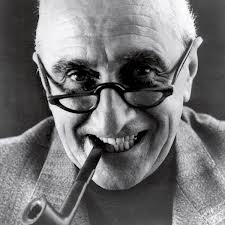 Luigi Caccia Dominioni was born in 1913 in Milan, where he graduated in architecture in 1936. In the same year he began practising in partnership with Livio and Pier Giacomo Castiglioni and together with them he developed a reputation as a pioneer of industrial design. Their collaboration resulted in some particularly important projects of a series of radio sets for Phonola and a wide research on cutlery. His 'Caccia' cutlery range comes from this research and is on permanent display at the Museum of Modern Art in New York. From 1950 to 1980 he designed numerous buildings in Italy and across Europe - the Viboldone monastery, the churches of St. Biagio at Monza, the housing estates at San Felice in Milan and at Monticello, the Parc San Roman skyscraper in Monaco. He also reconstructed the Poldi Pezzoli Museum in Milan. In the '50s he set up, together with Gardella and Corradi, Azucena which is a collection of the furniture and objects he designed.
Luigi Caccia Dominioni was born in 1913 in Milan, where he graduated in architecture in 1936. In the same year he began practising in partnership with Livio and Pier Giacomo Castiglioni and together with them he developed a reputation as a pioneer of industrial design. Their collaboration resulted in some particularly important projects of a series of radio sets for Phonola and a wide research on cutlery. His 'Caccia' cutlery range comes from this research and is on permanent display at the Museum of Modern Art in New York. From 1950 to 1980 he designed numerous buildings in Italy and across Europe - the Viboldone monastery, the churches of St. Biagio at Monza, the housing estates at San Felice in Milan and at Monticello, the Parc San Roman skyscraper in Monaco. He also reconstructed the Poldi Pezzoli Museum in Milan. In the '50s he set up, together with Gardella and Corradi, Azucena which is a collection of the furniture and objects he designed.
Without a doubt, the entire work of Luigi Caccia Dominioni is based on the principle of synthesis. The design of the furnishings and fittings is always in close harmony with the structure of the interior. Thus, for example, the mosaics by Francesco Somaini are an integral component of the overall composition of the building, which is seen as a complex organism. Caccia has explained on several occasions that he primarily sees himself someone who designs whole complexes. The draft of the plan, which in his logic follows the movements of people, gives rise to considerations that are channelled into the facade design. A further spin-off of this process are ideas for the design of objects, furnishings, accessories, lamps, handles and doors - designs that received the Compasso d'Oro award in 1985. Such ideas embrace a permanent exchange between the private and public spheres. These two areas are both tackled with equal intensity, whereby particular attention is given to the spatial quality of the axes and transitions, to corridors in private apartments, to public galleries in large buildings, to stairways and linking elements. One example of the latter is the link, built in 1968-70, between the San Fedele church and the Chase Manhattan Bank of the BBPR in the centre of Milan - which is pure genius.
To meet the demand for the furniture and products he designed and restored, he teamed up with Ignazio Gardella, Corrado Corradi Dell'Acqua, Maria Teresa and Franca Tosi in 1947 to co-found Italy's first business for the production and sale of objects and items of furniture: Azucena. The Italian company Azucena was not so much a range of modern furniture with avant-garde appeal than an assortment of isolated design items that emerged after a long design phase and were intended to furnish the interiors of the new buildings. It was only in a second phase that the collection was wrought into a modern range of furnishings, that - fifty years on - now certainly has to be seen as an important chapter of Italian design history. It is immediately apparent from the collection that it had more than one root and was almost always designed around some concept of architectural space. Experimentation, elegance, scale, essential nature and inventiveness: these concepts characterise the items that Azucena designed - always working towards an interior design concept to which the items relate in terms of their conceptual and objective intensity. "Azucena", states Marco Romanelli, "is a symbol for a certain type of project development which is characteristic of improved, Italian design - a project development which is always rooted in the dimension of interior design or understands this as its core. It is a control possibility and a fantasy which simultaneously lead from the environment to the object and from the object to the environment."
T24 Base Quadra, 1973
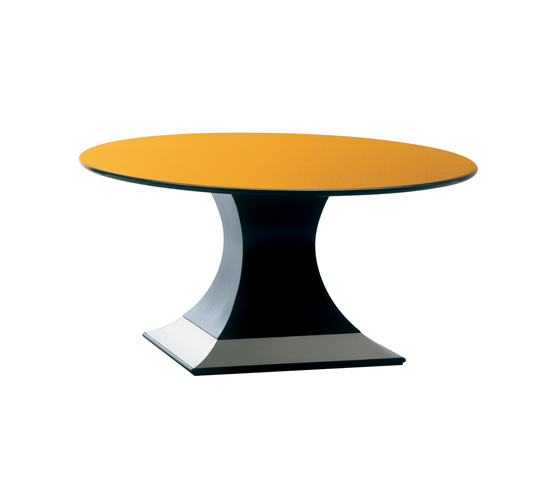 Named for its base made for supporting extra-large tops, this dining table has a rare brilliance. The polyester gloss lacquer reduces light absorbency making the top into a yellow (or black) reflective mirror. The steel band on the base protects the table from scuffing and above all, on account of the material and its inclination with respect to the floor, adds a mirrored surface that multiplies the effects of the light. Also in the version with the mahogany top with black gloss lacquered rounded edge, the Base Quadra is one of the many pieces designed by Luigi Caccia Dominioni that emanates indirect light.
Named for its base made for supporting extra-large tops, this dining table has a rare brilliance. The polyester gloss lacquer reduces light absorbency making the top into a yellow (or black) reflective mirror. The steel band on the base protects the table from scuffing and above all, on account of the material and its inclination with respect to the floor, adds a mirrored surface that multiplies the effects of the light. Also in the version with the mahogany top with black gloss lacquered rounded edge, the Base Quadra is one of the many pieces designed by Luigi Caccia Dominioni that emanates indirect light.
T20 Fascia Specchiata, 1970
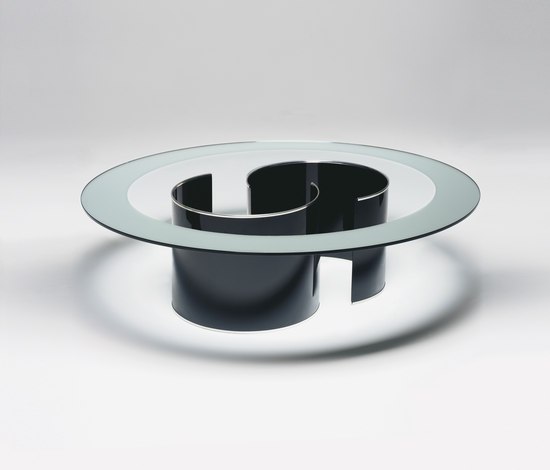 Like many of the other tables designed by Luigi Caccia Dominioni, the size of the table top and the height can be varied without losing the sense of the design. This has been concentrated on achieving two particular qualities, luminosity and a softness of line. The unusually shaped glass top, an almost circular oval, is bordered by a mirrored band that emphasises the unusual proportion. The half cylinders of the base are in black or grey iron or stainless steel and finished with a slender polished chrome profiling that projects a ray of light onto the transparent top.
Available in the perfect size for a coffee table or comfortable dining table. In both cases the images reflected by the mirrored ring rebound and animate the surrounding space.
Like many of the other tables designed by Luigi Caccia Dominioni, the size of the table top and the height can be varied without losing the sense of the design. This has been concentrated on achieving two particular qualities, luminosity and a softness of line. The unusually shaped glass top, an almost circular oval, is bordered by a mirrored band that emphasises the unusual proportion. The half cylinders of the base are in black or grey iron or stainless steel and finished with a slender polished chrome profiling that projects a ray of light onto the transparent top.
Available in the perfect size for a coffee table or comfortable dining table. In both cases the images reflected by the mirrored ring rebound and animate the surrounding space.
P4 Catilina, 1958
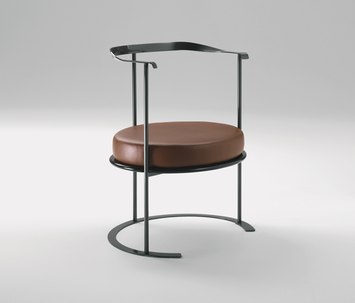 Catilina was unveiled in 1957 at the 11th Triennale in Milan and was used in an exhibition of Italian sculptor Francesco Somaini's works in Como the following year. It has since come to be considered a milestone in the history of Italian design. Catilina has been revisited over the course of the years and is currently available in a number of versions, including a small version (for use with tables), a steel version (plays on reflected light) and a low version (virtually an armchair). The curve of the backrest follows a precisely alculated geometry. The issue was to model an iron bar into a ribbon that would compensate for the severity of the seat. A few short centimetres are all that is required for the ribbon of metal to curve into a comfortable high armrest. By this alchemy the sitter is offered the luxury of gliding their back along the sinuous contours of the backrest while remaining elegantly upright. The frame in metallic automobile grey powder-coated cast iron supports an oval seat in black gloss-lacquered wood and leather or velvet cushion.
Catilina was unveiled in 1957 at the 11th Triennale in Milan and was used in an exhibition of Italian sculptor Francesco Somaini's works in Como the following year. It has since come to be considered a milestone in the history of Italian design. Catilina has been revisited over the course of the years and is currently available in a number of versions, including a small version (for use with tables), a steel version (plays on reflected light) and a low version (virtually an armchair). The curve of the backrest follows a precisely alculated geometry. The issue was to model an iron bar into a ribbon that would compensate for the severity of the seat. A few short centimetres are all that is required for the ribbon of metal to curve into a comfortable high armrest. By this alchemy the sitter is offered the luxury of gliding their back along the sinuous contours of the backrest while remaining elegantly upright. The frame in metallic automobile grey powder-coated cast iron supports an oval seat in black gloss-lacquered wood and leather or velvet cushion.
LP26B ONDA, 2003
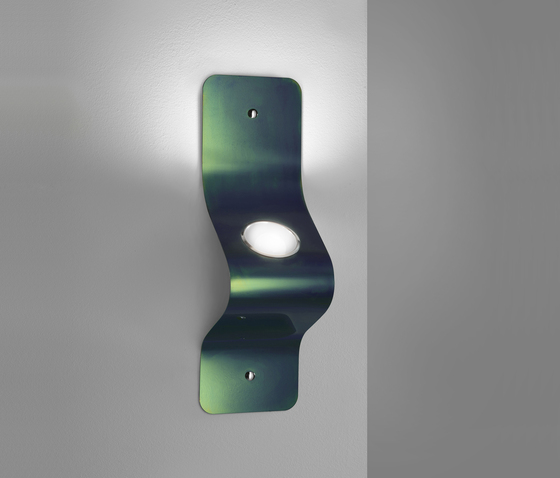 Wall light made of a single iridescent electro-coloured wave-shaped steel strip, scarab-beetle colour, with chrome-plated studs.
Wall light made of a single iridescent electro-coloured wave-shaped steel strip, scarab-beetle colour, with chrome-plated studs.
LTE5 IMBUTO, 1953
 Imbuto (Funnel) is the quintessential floor lamp, a stem of light stretching upwards. It was born as a tribute to the candle, the progenitor of all lamps. So why not extrapolate the essentials of the candle and reconstruct them according to the laws of electricity? A twenty-centimetre circular cast iron base serves to anchor the slim polished or chrome-plated brass stand.
The stem dilates ever so slightly at the top, creating a florescent repository that flows into the upturned cone of the reflector and lamp holder. Luigi Caccia Dominioni appropriately calls the lamp a "champagne flute" for its stylish form. Today it hosts a halogen lamp that produces a light of purest white to illuminate the surrounding space.
Imbuto (Funnel) is the quintessential floor lamp, a stem of light stretching upwards. It was born as a tribute to the candle, the progenitor of all lamps. So why not extrapolate the essentials of the candle and reconstruct them according to the laws of electricity? A twenty-centimetre circular cast iron base serves to anchor the slim polished or chrome-plated brass stand.
The stem dilates ever so slightly at the top, creating a florescent repository that flows into the upturned cone of the reflector and lamp holder. Luigi Caccia Dominioni appropriately calls the lamp a "champagne flute" for its stylish form. Today it hosts a halogen lamp that produces a light of purest white to illuminate the surrounding space.
P17 SANT'AMBROGIO, 1981
 His elegantly sober straight-backed sofa will sit comfortably against the wall, however, like all Azucena furnishings, it can also be used to define different spaces thanks to the clean, upright lines of the back. The backrest is slightly inclined and the armrests serve to "close off" the lateral perspective with the geometric forms connecting at points of inflection. The base of the sofa has a tied coil spring construction and cushions. It can be covered in any material, although it was originally in soft mohair velvet; traditional colourings are dark green or FFSS red (once used by the Italian railways in its first class carriages). The sides of the Sant'Ambrogio armchair embrace the seat slightly more than the sofas. This variation was born of the simple but pertinent observation that people sit "fronton" in armchairs, resting their head against the wings.
His elegantly sober straight-backed sofa will sit comfortably against the wall, however, like all Azucena furnishings, it can also be used to define different spaces thanks to the clean, upright lines of the back. The backrest is slightly inclined and the armrests serve to "close off" the lateral perspective with the geometric forms connecting at points of inflection. The base of the sofa has a tied coil spring construction and cushions. It can be covered in any material, although it was originally in soft mohair velvet; traditional colourings are dark green or FFSS red (once used by the Italian railways in its first class carriages). The sides of the Sant'Ambrogio armchair embrace the seat slightly more than the sofas. This variation was born of the simple but pertinent observation that people sit "fronton" in armchairs, resting their head against the wings.
L15 Bicolore, 1989
 Part of the latest production by architect Luigi Caccia Dominioni, Bicolore bed represents the re-interpretation in a contemporary key of the traditional bed, as an alternative to the typologies of upholstered bed or futon.
Part of the latest production by architect Luigi Caccia Dominioni, Bicolore bed represents the re-interpretation in a contemporary key of the traditional bed, as an alternative to the typologies of upholstered bed or futon.